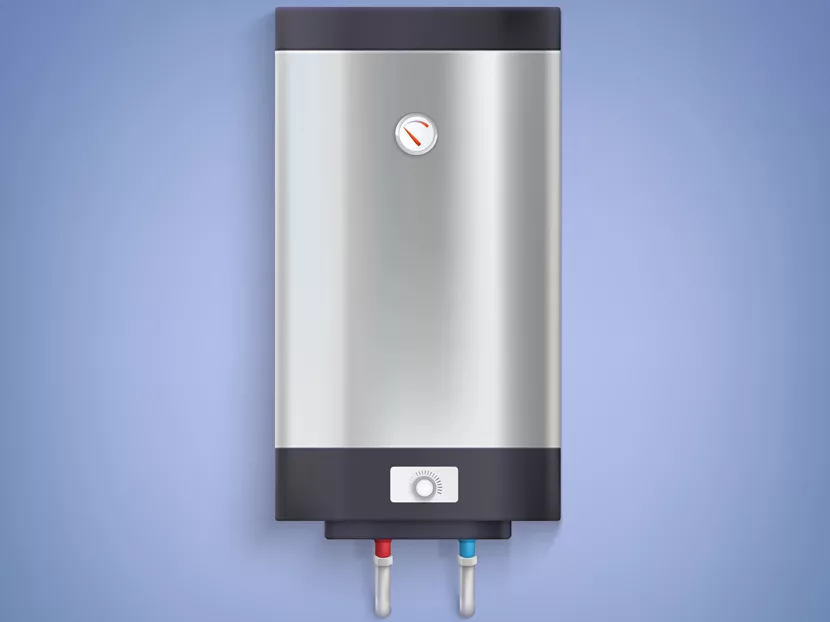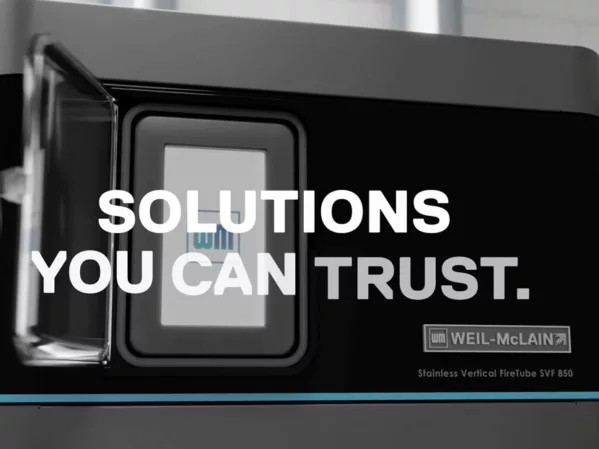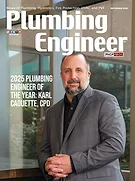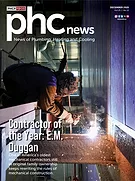This is a continuation of a summary of the significant code changes to the 2021 Uniform Plumbing Code (UPC) which is developed and promoted by the International Association of Plumbing and Mechanical Officials.
These code changes will appear in the 2021 edition of the International Plumbing Code. Because it is possible for modifications to be made during the final hearing process and because there were multiple changes made to some code sections, the final edited version may be slightly different than what was in the actual code change proposal. Refer to the 2021 International Plumbing Code for the final version of any code changes.
The proposed new code language is underlined. The text proposed to be deleted is stricken through. The proposed changes are followed by the proponent’s published reason statements, and occasionally by my comments when noted.
Last month, one of the code changes I covered omitted the underline for the new text in section 417.6. The new text is repeated here so that it is clear this was new code language. The reason statement was published in February’s column.
417.6 Low-Pressure Water Dispenser. Beverage faucets shall comply with ASME A112.18.1/CSA B125.1. Low-pressure water dispensers that dispense electrically heated or chilled water and have a reservoir vented to the atmosphere shall comply with ASSE 1023 and UL 399.
The following continues the significant code changes for the new 2021 Uniform Plumbing Code.
Code Change: 2021 UPC Code, Chapter 4, Plumbing Fixtures and Fixture Fittings, Section 416.0
Revise text as follows:
416.2 Water Supply. Emergency eyewash and shower equipment shall not be limited in the water supply flow rates. Where hot and cold water is supplied to an emergency shower or eyewash station, the temperature of the water supply shall be controlled by a temperature actuated mixing valve complying with ASSE 1071. Where water is supplied directly to an emergency shower or eyewash station from a water heater, the water heater shall comply with ASSE 1085. The flow rate, discharge pattern, and temperature of flushing fluids shall be provided in accordance with ISEA Z358.1.
Add new standard to Table 1701.1 Referenced Standards as follows:
TABLE 1701.1
REFERENCED STANDARDS
STANDARD NUMBER |
STANDARD TITLE |
APPLICATION |
REFERENCED SECTIONS |
ASSE 1085-2018 |
Water Heaters for Emergency Equipment |
Appliances |
416.2 |
(Portions of the table not shown remain unchanged).
Proponent’s reason statement: When this code change was originally submitted, ASSE 1085 was not yet completed. In October 2018, the standard was published as an ANSI standard. As such, the proposed change can now be accepted based on IAPMO policy. The original supporting statement justifies the inclusion of this new standard. The use of ASSE 1085 water heaters will become an option, not a mandatory requirement.
My comments: While using a tankless water heater for emergency fixture installations, it is important for the design professional and the installer to consider the application, especially if there can be significant flow changes associated with widely varying flows. These are common with combination eyewash and emergency shower fixtures.
Verify that the tankless water heater or temperature control valve you select can maintain temperature control when the eyewash is the only fixture activated at approximately 3 to 4 gallons/minute and when the emergency shower and eyewash are both activated at approximately 24 gpm. Many tankless or instantaneous water heaters experience significant temperature fluctuations associated with changes in flow rates during use.
This could create a dangerous condition if the equipment selected has a delay reacting to the sudden change in flow from an eyewash flow rate to operating both the eyewash and shower flow rate and then back to just the eyewash flow rate. This sudden change in flow while a person is flushing their eyes could present scalding hazards or cause damage to the eyes with temperatures over 100 F for the flushing period.
Code Change: 2021 UPC Code, Chapter 5, Water Heaters, Section 501, Table 501.1(1) and Table 1701.
Revise text as follows
Table 501.1(1)
Water Heaters
Type |
Standard |
Electric, Household Storage |
UL 174 |
Oil-Fired Storage Tank |
UL 732 |
Gas Fired 75,000 Btu/h or less, Storage |
CSA Z21.10.1 |
Gas-Fired, Above 75,000 Btu/h, Storage and Instantaneous |
CSA Z21.10.3 |
Electric, Commercial Storage |
UL 1453 |
Solid Fuel-Fired |
UL 2523 |
Electric Instantaneous |
UL 499 |
Revise text as follows:
TABLE 1701.1
REFERENCED STANDARDS
STANDARD NUMBER |
STANDARD TITLE |
APPLICATION |
REFERENCED SECTIONS |
UL 499-2014 |
Electric Heater Appliances (with Revisions thru Feb 23, 2017) |
Appliances |
Table 501.1(1) |
(Portions of the table not shown remain unchanged).
Proponent’s reason statement: Electric instantaneous water heaters are becoming a common appliance in homes and commercial installations. The UL standard for listing and certifying instantaneous water heaters is UL 499. It should be added to this list of standards used for other types of water heaters.
Adding the terms “storage,” ”fired” and “instantaneous” where applicable to the titles of the existing standards in this table will help authorities having jurisdiction verify compliance with the appropriate standards. These standards are titled, UL 174 Household Electric Storage Tank Water Heaters
My comments: The manufacturers refer to these products as tankless water heaters, while this code change refers to these products as instantaneous water heaters. The title of the referenced standards for electric water heaters are UL 499 Electric Heater Appliances and UL 174 Household Electric Storage Water Heaters.
They are not called instantaneous water heaters in the standard because there is no such thing as an electric instantaneous water heater. There is always a time vs. energy, input vs. flow rate and temperature rise that is not instantaneous because of the laws of physics and thermodynamics (heat transfer).
There are some types of electric tankless water heaters that simply operate with a flow switch to turn the electric energy on and off, based on a minimum flow rate required to activate a flow switch and energize the heating element. These water heaters have no temperature controls.
Some are equipped with flow control valves. As flow increases above the flow rate required to activate the flow switch, the temperature will drop as flow increases. So, in some cases, a throttling valve is needed to restrict flow to maintain a desired temperature rise at a predetermined maximum flow rate based on the energy input.
More sophisticated electric tankless water heaters include thermistors and temperature controls, but they also have temperature fluctuations with changes in flow. There are also gas-fired tankless water heaters that can have a wide range in temperature control capabilities, depending on the control and burner sophistication.
In theory, tankless heaters can control hot water system temperatures, but in practice, tankless heaters with temperature controls must rely on temperature sensors to operate modulating relays. These relays can vary the power to the heating elements or fuel to burners, or switch the power on and off or fuel at preset and adjustable temperature set-points.
When the controls have an on and off temperature set-point, it creates a sine wave or fluctuating temperature outlet. So tankless water heaters generally cannot accurately control the outlet temperature when there are widely varying flows.
The controls can adjust the energy input or stage on additional heating elements or burner sections, which can provide better control, but there will always be temperature fluctuations as flows change. The degree of fluctuation depends on the sophistication of the controls, which will drive up the price of the tankless heaters.
Likewise, with respect to other temperature control options for design professionals or contractors, temperature-actuated mixing valves use various types of thermal motors to actuate or move the shuttle in the valve that adjusts the proportion of hot and cold water. Generally, bi-metal coils are less reactive and not used as often in emergency fixture applications.
Liquid paraffin wax elements are more reactive and the larger the paraffin wax temperature sensing element, the more accurate the valve will be. For liquid paraffin wax models, larger thermal motor size generally means more accuracy and cost. Digital mixing valves rely on measuring resistance in the water based on its heat, which changes its density, and are generally more accurate temperature controllers.
With this code change, there also was a public comment to add a solar water heater standard titled, ICC 900/SRCC 300 Solar Thermal System Standard, ICC 901/SRCC 100 Solar Thermal Collector Standard, and UL 1279 Outline for Investigation of Solar Collectors. There were six committee members that supported adding these standards to the code to provide a standard for solar water heater systems.
The vote to add the solar standards failed. I suspect they might revise the submittal and bring it up again in the future so that solar water heaters will have a reference standard in the code.
Code Change: 2021 UPC Code, Chapter 5 Water Heaters, Table 501.1 (2)
Revise text as follows:
Table 501.1.(2)
First Hour Rating1
Number of Bathrooms |
1 to 1.5 |
2 to 2.5 |
3 to 3.5 |
||||||||
Number of Bedrooms |
1 |
2 |
3 |
2 |
3 |
4 |
5 |
3 |
4 |
5 |
6 |
First Hour Rating2 Gallons |
|
|
|
|
|
|
|
|
|
|
|
Proponent’s reason statement:
• Technical merit of the code change. The U.S. Department of Energy significantly revised the test procedures for measuring the efficiency of residential water heaters. Those revisions include changes to the method for determining the first-hour rating (FHR) of all residential storage water heaters. Manufacturers were required to display the revised FHR starting in June 2017.
The general effect of the revised method is an FHR that is lower than the previous value determined for a given model. As a result, the FHR requirements in the table noted above must be edited to reflect the new procedure for determining the FHR.
The revised DOE test procedure can be found on the DOE website.
Also attached is the Dec. 29, 2016, final rule that provided conversion factors to adjust existing ratings to the new test procedure. The table on page 96232 shows the conversion factors for the first hour ratings of the various types of water heaters.
• Emergency nature of the code change. If these changes are not made to the Uniform Plumbing Code, products that met the current requirements and which have not changed in their design or input rating will no longer comply with the table.
Also, the table, if unchanged, will drive contractors to select larger, higher-cost water heaters, which are oversized to meet the needs of the applications. Those selections will not be the most cost-effective, efficient choice for the consumer. If the table is unchanged, the revised DOE method for measuring FHR will make the table more restrictive.
Public comment: This was accepted as a Tentative Interim Amendment (TIA). The table must be changed to be consistent with what was in the code for the 2015 and previous editions. When the Department of Energy revised the test procedure, the first-hour rating of water heaters was lowered. Thus, a 38-gallon FHR of today equates to a 42-gallon FHR of 2015.
Without accepting this change and TIA, the rejection results in a code change requiring a larger water heater without any technical justification. If a larger water heater is desired, then a code change should be submitted with technical justification as to why a larger water heater is necessary.
Code Change: 2021 UPC Code, Chapter 5 Water Heaters, Section 508.2
Revise text as follows:
508.2 Installation of Appliances on Roofs. (remaining text unchanged)
508.2.1 Edge of Roof Clearance. Appliances shall be installed on a well-drained surface of the roof. At least 6 feet (1829 mm) of clearance shall be available between any part of the appliance, and the edge of a roof or similar hazard, or rigidly fixed rails, guards, parapets, or other building structures at least 42 inches (1067 mm) in height shall be provided on the exposed side. [NFPA 54:9.4.2.2]
508.2.1.1 Guards and Rails. Guards or rails shall be required where the following exist:
(1) The clearance between the appliance and a roof edge or open end of an equipment platform is less than 6 feet (3048 mm).
(2) The open end of the equipment platform is located more than 30 inches (762 mm) above the roof, floor, or grade below.
Where guards or rails are installed, they shall be constructed so as to prevent the passage of a 21-inch (533 mm) diameter ball, resist the imposed loading conditions, and shall extend not less than 30 inches (7625 mm) beyond each side of the equipment or appliance. Exception: Guards shall not be required where a permanent fall arrest anchorage connector system in accordance with ASSE Z359.1 is installed.
Revise text as follows:
TABLE 1701.1
REFERENCED STANDARDS
STANDARD NUMBER |
STANDARD TITLE |
APPLICATION |
REFERENCED SECTIONS |
ASSE Z359.1-2016 |
The Fall Protection Code |
Miscellaneous |
508.2.1.1 |
(Portions of the table not shown remain unchanged).
Proponent’s reason statement: The proposed language addresses the Technical Committee’s concern by keeping the National Fire Protection Association extract and adding additional provisions to address “guards and rails.” The added language gives the end-user clear guidance when guards and rails are required for safety, and the minimum requirements for physical characteristics.
Furthermore, the proposed language addresses “fall arrest anchorage connectors systems” as an alternate method of ensuring the safety of inspectors and workers on platforms and roofs
Code Changes: Chapter 5 Water Heaters, miscellaneous changes
There were several miscellaneous code changes in Chapter 5 dealing with venting requirements and most of these changes were to bring the UPC code language in line with the NFPA 54 National Fuel Gas Code language.
One significant addition was adding a new standard for venting water heaters: UL 1738 Venting Systems for Gas Burning Appliances. Categories II, III & IV (with revisions through Nov. 7, 2014). While the addition of the UL 1738 standard is a good reference standard, this standard was recently modified by a proposal from a plastic pipe manufacturer to add testing requirements for plastic pipe including PVC, CPVC and polypropylene plastic pipe as a flue-venting material for venting fuel-burning appliances.
My comments: I personally do not agree with the addition of plastic piping for flue-venting material for fuel-burning appliances because the plastic pipe has a very low melting point. When systems are not maintained properly, the plastic flue pipe can melt, collapse and cause a carbon monoxide issue or cause a fire. I have investigated many plastic flue pipe failures that resulted in carbon monoxide injuries and deaths.
Class A fires are defined as “ordinary combustibles.” These classes of fires are fires from commonly combustible material as their fuel source — wood, fabric, paper, trash and plastics. Class A combustible products typically have a combustion point between 350 Fand 750 F. This code change now allows a Class A combustible fuel to be used as a flue-venting material.
I think the codes need to go one step further and mandate that any fuel-burning equipment allowing plastic flue pipe materials to have a temperature sensor in the flue outlet connection to shut-off the burner when the flue gas temperature exceeds the temperature limit of the connected fuel material. Many of these fuel-burning appliances can have flue gas temperatures that exceed 300 F to 500 F when the heat exchanger is fouled or if a furnace filter is dirty.
Most manufacturers of PVC pipe have warnings not to use their pipe material for venting combustible flue gasses. One manufacturer of plastic pipe that I spoke to that promotes their plastic pipe for flue materials admitted the PVC plastic pipe they make for flue materials with stickers that shows it was tested to UL 1738 is the same plastic pipe with the same temperature characteristics as their PVC plastic plumbing piping. They simply add the stickers to the pipe that is tested for UL 1738.
It appears the addition of the plastic pipe test in UL 1738 was written to create a test so that existing plastic pipe could be tested to the standard and allowed in many areas where they are currently not allowed. The test for plastic pipe in UL 1738 does not address thermal expansion stresses on fittings.
Using the logic for plastic flues, I wonder when someone will come out with wooden flues. Many of the plastic flue pipe failures I have inspected deal with fittings that cracked and separated at the base of the socket in the fitting due to expansion and contraction forces acting on the pipe and the fittings. Expansion and contraction forces are much larger in plastic flue pipe than they are in metal flue pipe by a factor of about four or five times the linear expansion, depending on the material and the temperature.
The UL 1738 test is easy to pass with a new, clean, high-efficiency appliance that will operate efficiently with low flue-gas temperatures. They should test with the heat exchanger fouled to get an idea of the expected flue gas temperatures. This test allows manufacturers to place stickers on the pipe showing conformance to the UL1738 standard.
The pipe is no different than the schedule 40 PVC pipe used elsewhere, except in some cases they may have UV inhibitors for protection from sunlight degradation. The UV inhibitors do not raise the temperature limits for the pipe resin or the pipe. PVC pipe has a temperature limit of 140 F; a few manufacturers have argued that they can use 149 F because there is no water in the pipe to cause it to yield. And they use this slightly higher temperature in the testing.
Most other manufacturers say the resin used for PVC pipe starts to yield at 140 F and that is why they limit the temperature to 140 F in their technical manuals. The flue gas temperatures of water heaters and furnaces during normal operation often exceed 140 F and even 149 F. Even with the nine-degree increase for PVC pipe, all plastic pipe flue materials are considered combustible Class A fuels and these materials are being used to vent hot flue gasses from the combustion chamber on fuel-burning appliances.
CPVC pipe has a temperature limit of 180 F and some high-temperature, high-density polypropylene plastic piping systems can withstand temperatures of 230 F.
Next month we will continue the significant code changes from the 2018 to the 2021 edition of the Uniform Plumbing Code.






